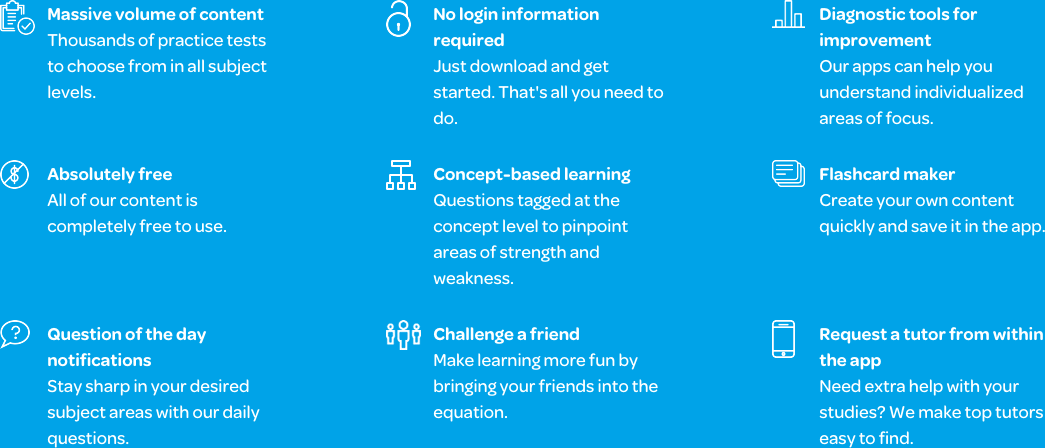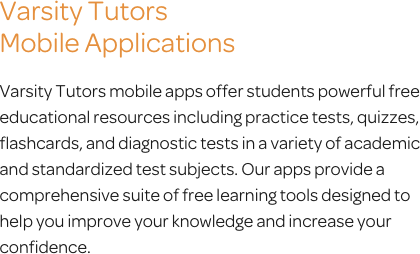The Varsity Tutors GRE Mobile App
Earning an advanced degree often begins with triumphing over the four-hour General Revised Exam, or GRE. The exam is akin to your SAT or ACT, and acts as a broad way to evaluate your abilities in reasoning, critical thinking, and analyzing. With the Varsity Tutors GRE Prep App available from iTunes and the Google Play Store, you can prepare for your GRE using your mobile device.
Through the app, you can get access to practice tests, concept explanations, flashcards, and more. You can use all of these tools together to build a customized study guide for the three sections of the GRE: Analytical Writing, Verbal Reasoning, and Quantitative Reasoning. Train yourself to understand quantitative data, articulate a clear argument, apply advanced concepts to the real world, and more.
Timed, full-length practice tests are designed to help you assess your skills. These tests simulate the real exam, and are based on past GRE exams. You will receive feedback that details your scores and mastery of different concepts after completing each practice test. Through the detailed data on your abilities, you may be able to identify the concepts that you should be practicing. You can choose a full-length practice test, or you can select a concept-specific practice test on the core concepts within each section. With the flexibility and results offered by the app, you can dedicate your study period to the areas that you need to focus on.
There are hundreds of GRE flashcards available that you can use to study specific concepts, or you can add to the flashcard library by creating your own with the Flashcard Maker. With these flashcards, you can take advantage of your spare time to study. Whether you prefer to quickly review before the test or would rather study while you travel, flashcards are an ideal study tool. In addition, they offer an excellent way to study with a partner or a group. The app offers a Question of the Day for each section of the GRE, too. It provides a different question each day that's taken straight from the practice tests. Upon answering, you are given a review of your solving time compared to that of others who answered the question, which concepts the question dealt with, and an explanation of the correct answer.
Use your Android or Apple device to brush up on coordinate geometry, algebraic functions, and basic math skills. There are also practice questions that provide graphs, charts, and other visual materials you’ll need to use. If there is a particular section, such as GRE Verbal Reasoning, that you find particularly challenging, you can focus your studies onto those basic concepts. The practice questions offer detailed explanations of the correct answer, along with the “why,” to improve your understanding of the required steps.
Give yourself a greater chance of success by taking the time to review, test, and prepare. By optimizing your study plan, you may be able to improve your chance of success on test day. Using a combination of the tools available on the app, you can create a streamlined study guide to maximize your review. You can study based on your needs. The Varsity Tutors GRE app makes it easy to fit quick study sessions into your schedule.
66 mobile apps to choose from for your tutoring needs.

Learn More
The Graduate Record Examination, or GRE, is taken by hundreds of thousands of prospective graduate and doctoral students each year. Administered by the Educational Testing Service in over 160 countries around the world, this standardized test is a requirement for admission to the majority of graduate programs in the United States. The GRE is also accepted by many graduate schools in other countries. It is intended for students who are in the senior year of an undergraduate program, and for those who have already earned a bachelor’s degree. First given in 1949, the GRE evaluates your skills in critical thinking, analytical writing, and verbal and quantitative reasoning. The test focuses on evaluating universal cumulative skills, as opposed to those that are field-specific.
The GRE underwent a significant revision in 2011. A new scoring system was adopted and certain question types were eliminated. The computerized version of the test now uses an algorithm that adjusts the difficulty of the entire second portion of the Verbal and Quantitative Reasoning sections, instead of using a question-by-question adjustment. Your score on the revised version of the GRE is viewed as an indicator of your potential for success as a graduate or business school student. Your GRE scores are valid for five years.
The GRE is made up of three scored sections, plus one unscored experimental section. The scored sections are divided into five parts. The test begins with the Analytical Writing section, which is split into two tasks. It is followed by two Verbal Reasoning sections, two Quantitative Reasoning sections, and the unscored experimental or research section. The sections following Analytical Writing may be given in any order. Including breaks, you will have just under four hours to complete the test. The Verbal and Quantitative sections are scored on a scale from 130 to 170, and the Analytical Writing section’s tasks are scored together on a scale from 0-6. Your score on the Analytical Writing section will not affect your scaled score.
The first section you will face on the GRE will always be the Analytical Writing section. This section evaluates your skills in supporting complex ideas in a clear, effective manner. It is broken into two 30-minute tasks: an issue task and an argument task. For the issue task, you will be asked to write an essay about one of the topics provided by the ETS. All of the topics are pulled from a set of questions available online, making it easy for you to prepare for this task. Having a general outline of the issue task topics you may face on the real test enables you to spend the allotted time writing a strong essay.
The argument task essay will test your skills in critical thinking and writing. You will be provided with an argument that you will critique in your essay. You must first take into account the existing logic of the argument, then present your thoughts on how the argument’s logic might be improved. Your focus is to be on the argument’s logical flaws, not your personal thoughts on the topic. These essay topics are also available online, so you can review the arguments in their entirety before test day. Each of your essays will be scored by two independent readers. Should the two scores differ by more than one point, a third reader will evaluate your essays to make a final decision.
The Quantitative Reasoning questions are divided into two 35-minute sub-sections with 20 questions apiece. This section assesses your competency in problem-solving and your mastery of basic skills and concepts involving arithmetic, algebra, and geometry. It will also test your skills in interpreting and analyzing data and other quantitative information. You are allowed to use a calculator on this section, which the testing center will provide. There are three types of questions you will encounter in this section: quantitative comparison, multiple-choice, and numeric entry. Some of the questions will be part of a data interpretation set, and will be based on graphs, tables, and charts. You will typically face eight quantitative comparison questions, nine problem-solving questions, and three data interpretation questions on each of the Quantitative Reasoning sections.
The Verbal Reasoning questions are also divided into two sections. Each section consists of 20 questions that you must answer within 30 minutes. This section measures your mastery of verbal analysis, reasoning, and comprehension skills. You must also know how to identify and distinguish main points from information that is less relevant. You may also be asked to summarize a text or to explain a text’s structure. There are three types of questions you will face within this section: reading comprehension, text completion, and sentence equivalence. There are both multiple-choice and fill-in-the-blank questions presented for each of these, and the passage-based reading comprehension questions are given in sets.
The GRE will also include an unscored experimental or research section. The experimental section contains questions that ETS may use on future editions of the test. Though this section is unscored, it is not identified as the experimental section, and it is formatted just like the scored sections. Since the Quantitative, Verbal Reasoning, and experimental sections are given in a random order, any of the five sections following the Analytical Writing tasks may be scored, and should be treated accordingly. However, research sections will be identified as such, and are always given at the end of the test. You are also given the option to decline to complete a research section.
It’s important to engage in adequate preparation before you attempt the GRE. Since your score is a major factor in the admissions decision process, you will want to present yourself in the best light possible. There are a great number of skills you will need to master before you take the test, so you will want to give yourself plenty of time to review. In general, a slow and steady approach is most effective. Focused, efficient, and regular study will enable you to approach test day with the confidence you need to succeed on the GRE.




